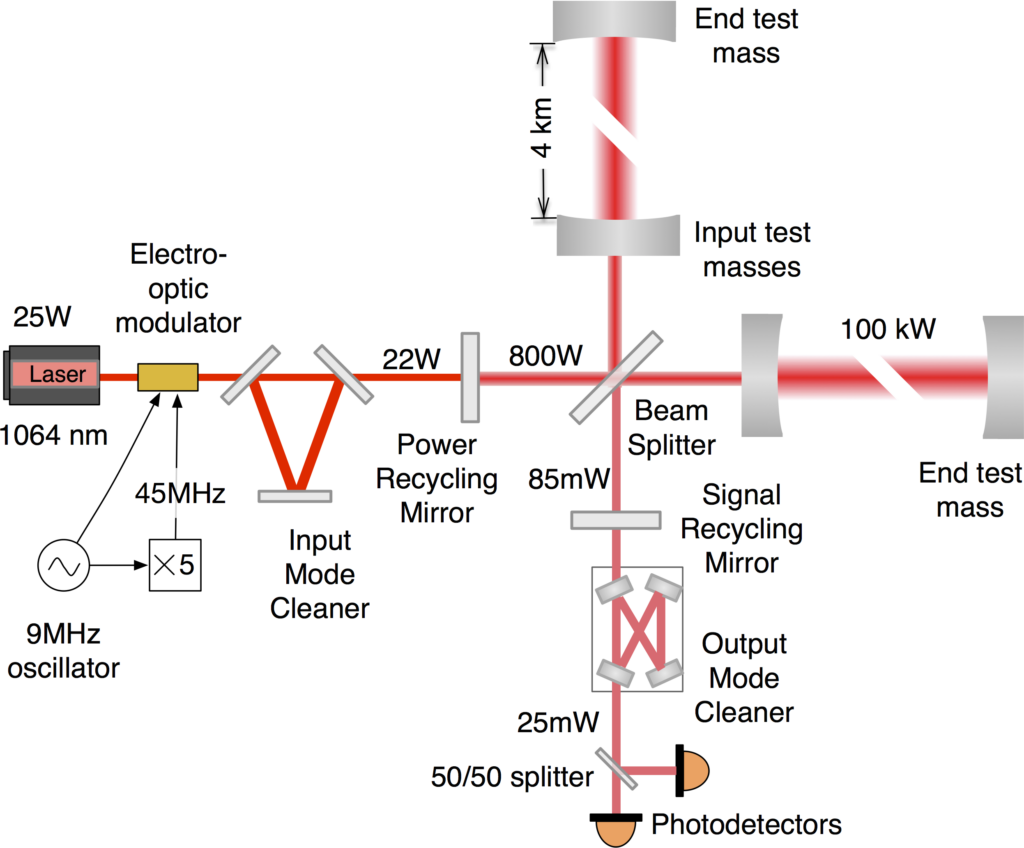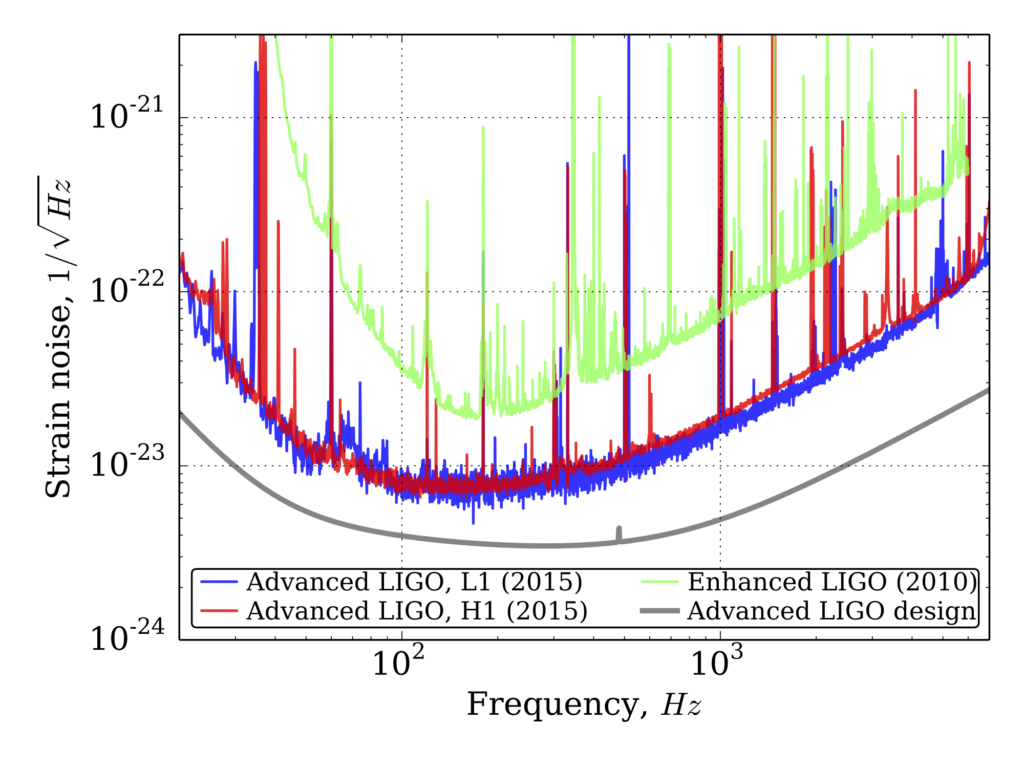On September 14, 2015, the two detectors Laser Interferometer Gravitational-wave Observatory (LIGO) observed a gravitational wave signal generated by the merger of two black holes. The LIGO detectors were recently upgraded with new instrumentation and now operate as Advanced LIGO, able to measure changes in the local shape of space-time with a precision better than one-thousandth the diameter of a proton. Gravitational waves are traveling perturbations in the shape of space-time, generated by cataclysmic events in distant galaxies. The detection of gravitational waves has been a long-held goal of the physics community, and represents a futher confirmation of Einstein’s Theory of General Relativity.Previous versions of the LIGO and Virgo detectors had searched for gravitational waves, but were not sensitive enough to distinguish true signals from the background noise of the detectors. The sensitivity improvement that lead to the discovery was the result of many decades of design and experience with the earlier instruments.
Following the detection announcement, the LIGO Scientific Collaboration (LSC) has published a paper, titled “The Sensitivity of the Advanced LIGO Detectors at the Beginning of Gravitational Wave Astronomy,” which describes a variety of noise sources and quantifies their impact on the detectors. The paper is intended to detail the physical processes which limited the sensitivity of the detectors during Advanced LIGO’s first observation run, which was conducted between September 12, 2015 and January 12, 2016. During this period, LIGO scientists only made instrument modifications when necessary to fix malfunctioning equipment, and the detectors were maintained in a low-noise observing state as much as possible.
The Signal and the Noise
The L-shaped LIGO instruments consist of two perpendicular arms, each two and one-half miles (4 kilometers) long. A passing gravitational wave will alternately stretch one arm and squeeze the other, and then vice-versa; this generates an interference pattern at the readout port of the interferometer, which is measured by photo-detectors.

Fig 1. The Advanced LIGO detectors are Michelson interferometers with 4-km long arms. The arms contain Fabry-Perot optical cavities to amplify the signal from a gravitational wave. The electromagnetic field from the laser is modulated at radio frequencies (9 and 45 MHz) to generate signals used to control the detector, and the spatial profile of the beam is cleanedf using an optical cavity (the Input Mode Cleaner). A mirror placed between the input mode cleaner and the beamsplitter (the Power Recycling Mirror) is used to recycle the laser power that is rereflected by the arms, and another mirror (the Signal Recycling Mirror) between the beamsplitter and the readout photodetectors is used to alter the frequency response of the interferometer. The Output Mode Cleaner removes excess laser light before the signal is measured by photodetectors.
Many non-gravitational signals can move the mirrors or affect the laser light in a way that can mimic or mask a gravitational wave signal. These noises are generated by many different physical phenomena, and the sum of all the noises leads to the familiar sensitivity curves of the detectors as a function of frequency (see Fig. 2). The detectors have been designed so that these noises are extremely quiet, but gravitational wave signals are equally small, and even the most imperceptible forces on the mirrors are enough to spoil the measurement.

Fig 2. In this figure, we show the amplitude spectral density of the detector noise. Gravitational wave signals with amplitudes lower than this noise floor are too quiet for the interferometers to detect. The sensitivity of the Advanced LIGO detectors in the first observing run (September 2015 to January 2016) was about a factor of three better than the instruments that collected data, in 2010. In the next few years, LIGO scientists will work to reduce the detector noise to the lowest achievable level with the current hardware (the ‘design sensitivity’ of the detectors).
Some examples of noise sources are:
- Seismic noise, due to the motion of the mirrors from ground vibrations, earthquakes, wind, ocean waves, and human activities such as vehicle traffic.
- Thermal noise, from the microscopic fluctuations of the individual atoms in the mirrors and their suspensions.
- Quantum noise, due to the discrete nature of light (composed of photons) and the statistical uncertainty from the “photon counting” that is performed by the photodetectors.
- Gas noise, from the interactions of the residual gas particles in the vacuum enclosure with the mirrors and the laser light.
- Charging noise, from the interaction of static electric charges on the glass mirrors with the metal of the vacuum enclosures and the mirror supports.
- Laser noises, for example small variations in the laser intensity and frequency.
- Auxiliary degree-of-freedom noise, due to the control of the position and alignment of the various mirrors in the detectors, and the slight cross-coupling between those mirrors and the measurement of the gravitational wave signal.
- Oscillator noise, generated by the radiofrequency modulation of the laser light, which is necessary for the control of the interferometer.
- Beam jitter, or slight variations in the position and angle of the laser beam in the detector, which can generate noise if they misalign the laser beam with respect to the optical cavities.
- Scattered light, generated by tiny imperfections in the mirrors of the interferometers, which can redirect a small fraction of the laser light towards the walls or other components of the instruments. If this light recombines with the main beam it will generate a spurious signal in the readout photodetectors.
- And finally, electronics noise, which is generated by the analog and digitial electronics that are used to measure the signal itself.
In the paper, the LSC shows that the amplitude (or volume) of these noise sources is generally within the expected level for the design of the instrument. A few sources of noise, such as beam jitter and scattered light, are shown to limit the sensitivity of the instruments in narrow frequency regions. These studies indicate avenues for improving the sensitivity through modifications to the detector equipment and control. With some effort over the next few years, the variety of noise sources will be reduced to the minimum levels for the current facilities and equipment.

Fig 3. An example “noise budget,” or accounting of sources of noise that combine to form the limiting sensitivity of the detectors. In this figure we show a variety of noise sources that affect the Livingston detector at low frequencies. The units on the y-axis are those of amplitude spectral density.
Read more:
- A free preprint of the paper is available at arXiv.org.
- A technical document describing the Advanced LIGO instruments was published in the journal Classical and Quantum Gravity and is available as a freely-readable preprint from arXiv.org.

